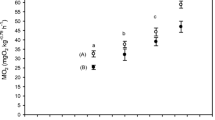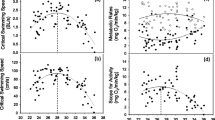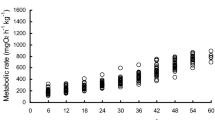Abstract
Schizothorax chongi (locally known as Xilian Yu), a fish species commonly found in Yalong River, has been declining quickly in recent years. One of the important factors, among many, is the interruption of the free flowing river by dams. To obtain data that can be applied to the design of a fishway for S. chongi and other species in the community, a laboratory study of juvenile S. chongi’s swimming energetics and kinematics was conducted in a flume-type respirometer equipped with a high speed video camera system to record swimming behavior. The aerobic metabolic rate, tail beat frequency (TBF) and tail beat amplitude (TBA) were measured during steady swimming at varying flow rates for fish of similar mass. A power function accurately describes the relationship between oxygen consumption rate (MO2) and swimming speed (U). The estimated standard metabolic rate (SMR) calculated from the power function was 445.34 mg O2 kg−1 h−1, similar to the experimental result of 431.5 mg O2 kg−1 h−1. The relationship between cost of transport (COT) and U was, characteristically, inverse bell-shaped, with COTmin = 44.6 J kg−1 m−1 at U opt = 5.5 body lengths per second (bl s−1). There was a significant positive linear correlation between TBF and U. The slope of the correlation (0.33) was lower than for many other species, implying that S. chongi swim efficiently. The TBA, ranging from 0.15 to 0.2 bl, was found to be independent of U. Kinematic analyses indicates that S. chongi primarily depends on the caudal fin to generate forward thrust and employs three velocity-dependent swimming gaits. This investigation provides data on the swimming ability of S. chongi that will add to the basic science required for fishway design.







Similar content being viewed by others
References
Alexander, R. M., 1989. Optimization and gaits in the locomotion of vertebrates. Physiological reviews 69: 1199–1227.
Behrens, J. W., Kim Prabel & J. F. Steffensen, 2006. Swimming energetics of the Barents Sea capelin (Mallotus villosus) during the spawning migration period. Journal of Experimental Marine Biology and Ecology 331: 208–216.
Boily, P. & P. Magnan, 2002. Relationship between individual variation in morphological characters and swimming costs in brook charr (Salvelinus fontinalis) and yellow perch (Perca flavescens). The Journal of Experimental Biology 205: 1031–1036.
Cheong, T. S., M. L. Kavvas & E. K. Anderson, 2006. Evaluation of adult white sturgeon swimming capabilities and applications to fishway design. Environmental Biology of Fishes 77: 197–208.
Fuggle, R. & W. T. Smith, 2000. Hydrosult Canada Inc., and Androdev Canada Inc., Experience with Dams in Water And Energy Resource Development in the People’s Republic of China. Country Review Paper Prepared for the World Commission on Dams, Cape Town, South Africa.
Hammer, C. & G. Schwarz, 1996. The effect of prolonged swimming activity on the growth, proximate body composition and calorific content of 0-age group whiting (Merlangius merlangus L., Gadidae). Archive of Fishery and Marine Research 44: 13–32.
Hepher, B., 1988. Nutrition of Pond Fishes. Cambridge University Press, Cambridge.
Hinch, S. G., E. M. Standen, M. C. Healey, et al., 2002. Swimming patterns and behaviour of upriver migrating adult pink (Oncorhynchus gorbuscha) and sockeye (O. nerka) salmon as assessed by EMG telemetry in the Fraser River, British Columbia, Canada. Hydrobiologia 483: 147–160.
Larinier, M., 2000. Dams and Fish Migration. World Commission on Dams, Toulouse, France.
Lin, P. J., I. H. Ni & B. Q. Huang, 2008. Evaluation of the swimming ability of wild caught Onychostoma barbatula (Cyprinidae) and applications to fishway design for rapid streams in Taiwan. Raffles Bulletin of Zoology 19: 273–284.
Lyon, J. P., T. J. Ryan & M. P. Scroggie, 2008. Effects of temperature on the fast-start performance of an Australian freshwater fish. Ecology of Freshwater Fish 17: 184–188.
Morita, K. & T. Suzuki, 1999. Shifts of food habit and jaw position of white-spotted charr after damming. Journal of Fish Biology 55: 1156–1162.
Morita, K. & S. Yamamoto, 2002. Effects of habitat fragmentation by damming on the persistence of stream-dwelling charr populations. Conservation Biology 16: 1318–1323.
Ohlberger, J., G. Staaks, P. L. M. van Dijk, et al., 2005. Modelling energetic costs of fish swimming. Journal of Experimental Zoology 303A: 657–664.
Ohlberger, J., G. Staaks & F. Hölker, 2006. Swimming efficiency and the influence of morphology on swimming costs in fishes. Journal of Comparative Physiology B 176: 17–25.
Ohlberger, J., G. Staaks & F. Hölker, 2007a. Effects of temperature, swimming speed and body mass on standard and active metabolic rate in vendace (Coregonus albula). Journal of Comparative Physiology B 177: 905–916.
Ohlberger, J., G. Staaks & F. Hölker, 2007b. Estimating the active metabolic rate (AMR) in fish based on tail beat frequency and body mass. Journal of Experimental Zoology 307A: 296–300.
Parrish, J. K. & W. K. Kroen, 1988. Sloughed mucus and drag-reduction in a school of Atlantic silversides, Menidia menidia. Marine biology 97: 165–169.
Peake, S. J. & A. P. Farrell, 2004. Locomotory behaviour and post-exercise physiology in relation to swimming speed, gait transition, and metabolism in free-swimming smallmouth bass Micropterus dolomieu. Journal of Experimental Biology 207: 1563–1575.
Peake, S. J. & A. P. Farrell, 2006. What triggers fatigue in respirometer-confined fishes? Journal of Fish Biology 68: 1742–1755.
Pettersson, L. B. & A. Hedenström, 2000. Energetics, cost reduction and functional consequences of fish morphology. Proceedings of the Royal Society B, Biological Sciences 267: 759–764.
Pon, L. B., S. G. Hincn, S. J. Cooke, et al., 2009. Physiological, energetic and behavioural correlates of successful fishway passage of adult sockeye salmon Oncorhynchus nerka in the Seton River, British Columbia. Journal of Fish Biology 74: 1323–1336.
Reidy, S. P., S. R. Kerr & J. A. Nelson, 2000. Aerobic and anaerobic swimming performance of individual Atlantic cod. The journal of Experimental Biology 206: 347–357.
Reyes-Gavilán, F. G., R. Garrido, A. G. Nicieza, et al., 1996. Fish community variation along physical gradients in short streams of northern Spain and the disruptive effect of dams. Hydrobiologia 321: 155–163.
Rodríguez, T. T., J. P. Agudo, L. P. Mosquera, et al., 2006. Evaluating vertical-slot fishway design in terms of fish swimming capabilities. Ecological Engineering 27: 37–48.
Rome, L. C., R. P. Funke & R. M. Alexander, 1990. The influence of temperature on muscle velocity and sustained performance in swimming carp. Journal of Experimental Biology 154: 163–178.
Steinhausen, M. F., J. F. Steffensen & N. G. Andersen, 2005. Tail beat frequency as a predictor of swimming speed and oxygen consumption of saithe (Pollachius virens) and whiting (Merlangius merlangus) during forced swimming. Marine Biology 148: 197–204.
Swanson, C., P. S. Young & J. J. Cech Jr., 1998. Swimming performance of delta smelt: maximum performance, and behavioral and kinematic limitations on swimming at submaximal velocities. Journal of Experimental Biology 201: 333–345.
Videler, J. J., 1993. Fish Awimming. In Fish And Fisheries Series 10. Chapman and Hall, London.
Videler, J. J. & B. A. Nolet, 1990. Cost of swimming measured at optimum speed: scaling effects, differences between swimming styles, taxonomic groups and submerged and surface swimming. Comparative Biochemistry and Physiology 97A: 91–99.
Videler, J. J. & C. S. Wardle, 1991. Fish swimming stride by stride: speed limits and endurance. Reviews in Fish Biology and Fisheries 1: 23–40.
Videler, J. J. & D. Weihs, 1982. Energetic advantages of burst-and-coast swimming of fish at high speeds. Journal of Experimental Biology 97: 169–178.
Wardle, C. S., N. M. Soofiani, F. G. O’Neill, et al., 1996. Measurements of aerobic metabolism of a school of horse mackerel at different swimming speeds. Journal of Fish Biology 49: 854–862.
Webb, P. W., 1971. The swimming energetics of trout I. Thrust and power output at cruising speeds. Journal of Experimental Biology 55: 489–520.
Webb, P. W., 1993. Swimming. In Evans, D. H. (ed.), The Physiology of Fishes. CRC Press, Boca Raton, FL: 47–73.
Wieser, W., 1991. Physiological energetics and ecophysiology. In Winfield, I. J. & J. S. Nelson (eds), Cyprinid Fishes: Systematics, Biology and Exploitation. Chapman and Hall, London: 427–455.
Yagci, O., 2010. Hydraulic aspects of pool-weir fishways as ecologically friendly water structure. Ecological Engineering 36: 36–46.
Zhu, D. & J. Chang, 2008. Annual variations of biotic integrity in the upper Yangtze River using an adapted index of biotic integrity (IBI). Ecological Indicators 8: 564–572.
Acknowledgments
This study was supported by funds from National Natural Science Foundation of China (No:50979049,50639070-4) and the Educational Commission for Distinguished Group of Hubei Province, China (No: T200703)
Author information
Authors and Affiliations
Corresponding author
Additional information
Handling editor: Nicholas R. Bond
Rights and permissions
About this article
Cite this article
Tu, Z., Yuan, X., Han, J. et al. Aerobic swimming performance of juvenile Schizothorax chongi (Pisces, Cyprinidae) in the Yalong River, southwestern China. Hydrobiologia 675, 119–127 (2011). https://doi.org/10.1007/s10750-011-0809-y
Received:
Revised:
Accepted:
Published:
Issue Date:
DOI: https://doi.org/10.1007/s10750-011-0809-y




